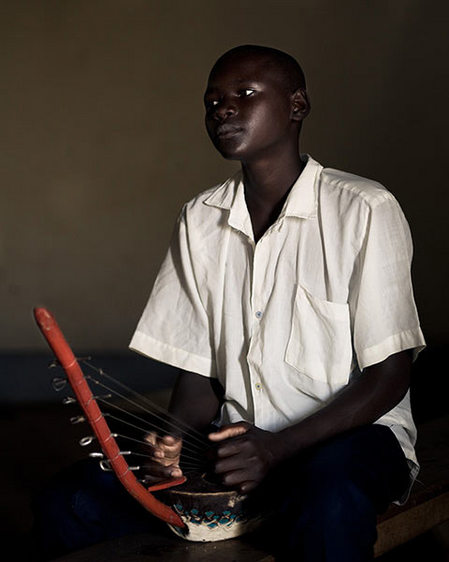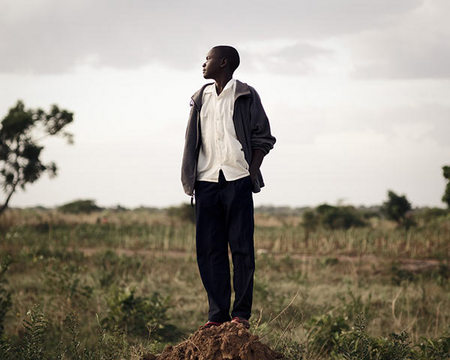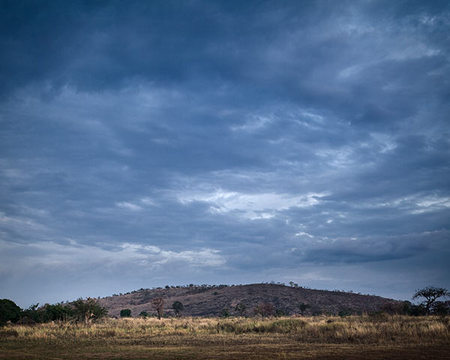A Conversation with CPC 2009 Winner David Wright
Photographically, the continent of Africa, home of around one billion people and cradle of humanity, seems to be in a bit of a tight spot. While there is a lot of different work being produced about or in Africa, the most visible types of photography, the ones we get to see most often, are either photojournalistic depictions of war and/or poverty or what Jim Johnson called the freak show. David Wright’s Alebtong, Uganda was thus a very pleasant surprise for me: A young photographer going to Africa and producing images that do not center on photojournalistic clichés or on the overly exotic.
Of course, I had been familiar with David’s work for a while - given Pause, To Begin. But with Alebtong, Uganda he clearly seemed to be upping the ante of his work quite a bit. There is no text on David’s website, so I did not know the background story of Alebtong, Uganda, but I became immediately intrigued - and this, for me, is one of the criteria for good photography: When you want to know more, when the work draws you in and makes you ask questions.
Some of those questions I asked David for the following conversation. Click on the images to see them slightly bigger (and, of course, they are copyright David Wright).
 Jörg Colberg: In your CV, it says you spent time in Uganda as a photographer and instructor. How did you get to do that job?
Jörg Colberg: In your CV, it says you spent time in Uganda as a photographer and instructor. How did you get to do that job?
David Wright: I started working for John Paul Caponigro along the coast of Maine in the fall of 2006. I was creating and implementing his digital archive, making prints for his exhibitions and clients, and assisting his workshops. It was a good position with great access to knowledge and equipment but I was always wanting to make more of a profound and worthwhile difference as I was not content working behind the computer.
A few days before Christmas in 2007 I began talking to John Paul’s wife, Ardie, about needing to go to Africa to help those in need. She mentioned that a good friend she went to school with, Chandler Griffin, founded a not-for-profit titled A River Blue, an arts empowerment project for the children of formerly internally-displaced persons camps in Northern Uganda. I have a strong, natural intuition and it was in this moment that I knew I would go to Northern Uganda. Chandler and I emailed back and forth for a few months getting to know each other, taking about our past experiences, learning about our plans for the future, and finding common interests.
I paid no rent and lived in a rustic trailer on the St. George River from September-December 2008 thanks to a good friend and former landlord I had met in Maine; a savings of $2,000 to put towards Uganda. It was both romantic and tiresome. There were wild turkeys, deer, and a pair of nesting bald eagles in a nearby pine tree. In the morning I would look out my bedroom window and see lobstermen hauling in their traps while the sun rose over the horizon. But there was no bathroom nor running water. There were insects inside during the warmer months and mice during the colder months. I heated the trailer with a wood burning stove next to my futon mattress laid on top of a piece of plywood. The wind would blow so hard that snow would literally come through the bottom of my door and into the trailer. I never kept the stove burning during the daytime for fear that the trailer would accidentally burn down while I was at work.
Chandler and I had emailed Fujifilm USA seeking a Fuji Instant Film donation, and they agreed to send the amount we asked for. We could not have been more thankful for their support. During this time I created a print sale marketed through generous online blogs. It was successfully and helped finance going to and making work in Northern Uganda. I would like to express grateful appreciation to my friends and family who purchased prints and made donations.
 JC: You took a fair amount of photos in Uganda. How did you approach the work? How did you figure out what to take photos of, to maybe avoid ending up with “touristy” photographs?
JC: You took a fair amount of photos in Uganda. How did you approach the work? How did you figure out what to take photos of, to maybe avoid ending up with “touristy” photographs?
DW: The first two weeks I made almost no photographs. I was living in Alebtong, a small village of approx. 1,000 people with no running water or electricity. I was the only white person for probably 45km in all directions. It was a very honest experience.
I spent a lot of time with George, the Director of A River Blue, and his family, whom I was staying with. It was the dry season and there had been no rain for almost 3 months so there was not much work or farming taking place. I walked around the village feeling the spirit of Alebtong and it’s people, and was able to better understand and direct the work I wanted to make. I developed a strong bond many of the people, especially George and his family, and Christopher, the art teacher at A River Blue, meeting his family, taking long walks through the bush, and breathing in the countryside. In spending time with the people and landscape I began to feel the photographs I wanted to make.
Alebtong is filled with a deep, compassionate spirit but has also suffered immense anguish. All of Alebtong’s people were greatly affected by the Lord’s Resistance Army. Most lived in internally displaced persons camps with depressing conditions. Many were killed, raped, forced to join the LRA, and endured appalling atrocities. The situation has been calm since 2005/2006 but the people continue to have mental and physical challenges because of the wars. I wanted the work to be composed of portraits, landscapes, and still lives where feelings of both sadness and happiness would be expressed through the work. Although I had these ideas in mind I wanted the work to happen naturally and many times making 1 photograph would lead to the next.
The A River Blue students and I used Fuji’s beautiful Instant Film to create 2 projects: 1. where last years ARB students made photographs of their village and 2. where this years ARB students made portraits of each other and then wrote about their respective portraits. Most of the students had never seen a picture of themselves and I will never forget watching them peeling apart the instant film for the first time. Everyone was jumping around, giggling, and making sounds of excitement. It was a phenomenal, special moment.
 JC: Let’s talk a little bit about portraiture. You take a lot of portraits. What interests you in portraits?
JC: Let’s talk a little bit about portraiture. You take a lot of portraits. What interests you in portraits?
DW: A few months ago I was having dinner with my parents and my mother stated that I rarely spoke during the first couple years of my life. Although I have no physical recollection of being one or two years old, I find this fact interesting and wonder if I was observing and digesting the beauty of everything I was beginning to see.
Regarding portraiture, I am interested in externally expressing who a person is internally. I want to be able to identify with a person and be able to express it through the created photograph. It sounds complex but I like things to be easily understood. I want my photographs to express that.
JC: I think I’d like to hear a little bit more about this, since from what you wrote it’s not very clear. Do you want your portraits to show what you see in people, or am I misunderstanding you?
DW: I create portraits of the moments that my subjects and I are experiencing. I always have ideas in mind prior to the shoot but I like to be open to serendipitous happenings. While photographing I listen to my intuition and go on feeling while also being aware of what’s happening in the situation and how the subject is feeling. Also, it depends on the assignment and what the photo editor and I are looking to make.
 JC: … and how do you approach taking a portrait? Do you guide your subjects?
JC: … and how do you approach taking a portrait? Do you guide your subjects?
DW: I tell my subjects that I am in control of the situation and act confident with my movements. I connect on a basic level and common interest, be it a book, a friend, a movie, etc. I often position my subjects in a specific place and tell them where to look. Sometimes we speak to one another and other times we’re quiet. There’s always the need to have subject and I to feel that the portrait is being given rather than taken. I believe that I’m a good listener, honest conversationalist, and strong observationalist. I find these important traits to make the photographs I make because when the subject believes we’re going to make a great photograph, we become closer to being able to do so.
JC: Who are you photographic/artistic influences?
DW: Although I am sometimes reserved, beneath the surface I feel deeply connected to emotion and feeling. I am fascinated in watching things every day, be it people, animals, trees, water, etc. Where I live impacts the photographs I make. For the past 3 years I lived along the ocean and in the countryside of Maine. It was remarkable and I began to fall in love with the people and landscape.
The act of running has always been a large part of my making photographs. A short while into a run my mind settles into a rhythm where thoughts flow freely. It’s meditative. This is where I sometimes see ideas. I turn off my mind and it somehow becomes awake. I find that life is mysterious and serendipitous in this way.
 While in photography school I was introduced to the work of Harry Callahan by my friend and great photographer, Kate Izor. I fell in love with Harry’s eye for beauty and ability to see elegance in all things simple. There are so many other great photographers I love and appreciate for various reasons: Sally Mann, Emmet Gowin, Doug Dubois, Alec Soth, Joyce Tenneson, Cig Harvey, etc.
While in photography school I was introduced to the work of Harry Callahan by my friend and great photographer, Kate Izor. I fell in love with Harry’s eye for beauty and ability to see elegance in all things simple. There are so many other great photographers I love and appreciate for various reasons: Sally Mann, Emmet Gowin, Doug Dubois, Alec Soth, Joyce Tenneson, Cig Harvey, etc.
Most recently I have been inspired by Dan Winters. I was listening to an interview of Dan online and he said, “People aren’t going to remember the things you do. They’re going to remember how you made people feel and I’ve always really tried to adhere to that. I try to be kind and gracious, and appreciative.” I admire Dan because he’s both creative and has a down-to-earth attitude; two things I always keep in mind when making work and living each day.
 By
By 